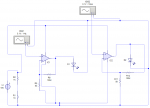- Joined
- Oct 26, 2007
- Messages
- 5,438
- Points
- 83
Good, you have some feedback in there. You'll want to make one of the resistors in each of the feedback resistor networks be a potentiometer so you can adjust the gain according to what your HDD galvos need. That'll require some experimentation on your part.







